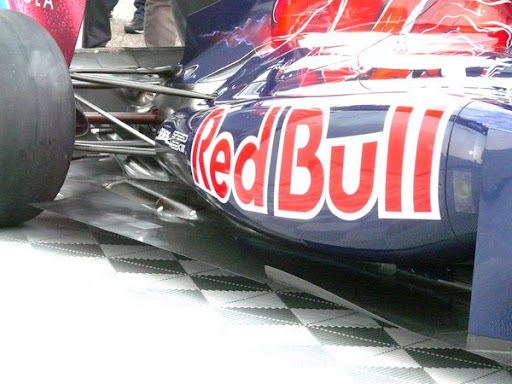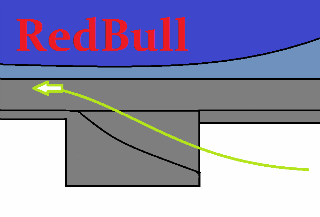- Login or Register
No account yet? Sign up



FIA F1 Fechnical Regulations 2012 – Article 3.12.4 wrote:3.12.4 The boundaries of the surfaces lying on the reference and step planes may be curved upwards with maximum radii of 25mm and 50mm respectively. Where the vertical transition meets the surfaces on the step plane a radius, no greater than 25mm, is permitted.
A radius in this context will be considered as an arc applied perpendicular to the boundary and tangential to both surfaces.
The surface lying on the reference plane, the surfaces lying on the step plane, the vertical transitions between them and any surfaces rearward of the surfaces lying on the reference or step planes, must first be fully defined before any radius can be applied or the skid block fitted.
Any radius applied is still considered part of the relevant surface.

OK then. We just have to add some louvres... Legal? you can't see this from beneath! and it's on the reference plane and/or the step planebeelsebob wrote:It's not legal...n smikle wrote:This is an illustration of my speculation..
3.12.1 With the skid block referred to in Article 3.13 removed all sprung parts of the car situated from 330mm behind the front wheel centre line to the rear wheel centre line, and which are visible from underneath, must form surfaces which lie on one of two parallel planes, the reference plane or the step plane.


Definitely illegal. Parts cannot be placed under the step plane.n smikle wrote:
OK then. We just have to add some louvres... Legal? you can't see this from beneath! and it's on the reference plane and/or the step plane
No, the transition between the two is on neither plane, and doesn't have the mandated 25mm/50mm curvature as mandated by the rule Intego quoted.n smikle wrote:OK then. We just have to add some louvres... Legal? you can't see this from beneath! and it's on the reference plane and/or the step planebeelsebob wrote:It's not legal...n smikle wrote:This is an illustration of my speculation..
3.12.1 With the skid block referred to in Article 3.13 removed all sprung parts of the car situated from 330mm behind the front wheel centre line to the rear wheel centre line, and which are visible from underneath, must form surfaces which lie on one of two parallel planes, the reference plane or the step plane.
That's not the step plane it's under – it's the reference plane. He's proposing something that transitions from step to reference plane underneath, the problem being that it would need too sharp an angle to be aerodynamically efficient.jordangp wrote:Definitely illegal. Parts cannot be placed under the step plane


But You can't see that part!beelsebob wrote:
No, the transition between the two is on neither plane, and doesn't have the mandated 25mm/50mm curvature as mandated by the rule Intego quoted.


Well the bodywork of the car can't go any lower than the floor bottom, which is the step plane, if that's what you're asking, with exception from the central section of the car, ie. the reference plane, and central diffuser section.neilbah wrote:i was more questioning if the cut/curve in the floor can be turned 90 degrees so its sideways to those examples in the toro/ferrari pics - providing of course that you can see only sky from below
Not speculating as to why this would or wouldnt be a good idea though. As people like to shoot others down

Article 3.12.4n smikle wrote:But You can't see that part!beelsebob wrote:
No, the transition between the two is on neither plane, and doesn't have the mandated 25mm/50mm curvature as mandated by the rule Intego quoted.
which rule intego quoted? In this thread?... I don't think it will apply to this..but if you can direct me to it. or tell me the rule number I will look at it.
Just out of interest - not directly related.. but look at these two.. the transition lies not on the step plane nor regference plane.. I think this is the free 50mm from the edge.. but still my design is all "flat" when viewed form below.
I think this type of floor curl (pioneered by rbr in 2009 iirc) is about a loophole in the rules that allows a maximum radius of 50mm at the floor edges - so it counts as reference plane.n smikle wrote:But You can't see that part!beelsebob wrote:
No, the transition between the two is on neither plane, and doesn't have the mandated 25mm/50mm curvature as mandated by the rule Intego quoted.
which rule intego quoted? In this thread?... I don't think it will apply to this..but if you can direct me to it. or tell me the rule number I will look at it.
Just out of interest - not directly related.. but look at these two.. the transition lies not on the step plane nor regference plane.. I think this is the free 50mm from the edge.. but still my design is all "flat" when viewed form below.

I can change the length of it... just the concept that I want to show.. notice the wording from the rules says step OR reference plane!beelsebob wrote:That's not the step plane it's under – it's the reference plane. He's proposing something that transitions from step to reference plane underneath, the problem being that it would need too sharp an angle to be aerodynamically efficient.jordangp wrote:Definitely illegal. Parts cannot be placed under the step plane
This one lies on the reference plane.and which are visible from underneath, must form surfaces which lie on one of two parallel planes, the reference plane or the step plane.
